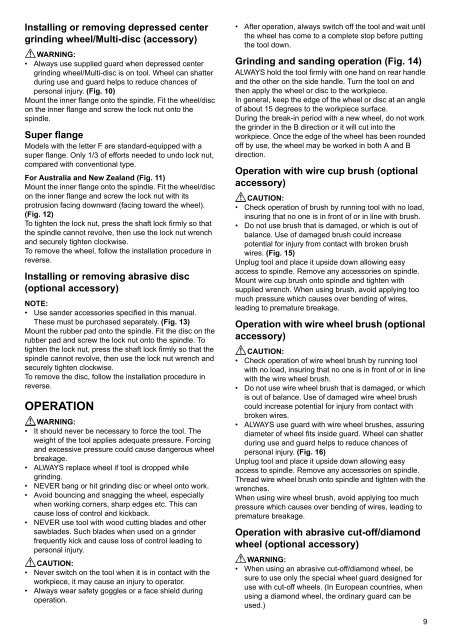Makita SMERIGLIATRICE ANGOLARE 230mm - GA9040R - Manuale Istruzioni
Makita SMERIGLIATRICE ANGOLARE 230mm - GA9040R - Manuale Istruzioni
Makita SMERIGLIATRICE ANGOLARE 230mm - GA9040R - Manuale Istruzioni
Create successful ePaper yourself
Turn your PDF publications into a flip-book with our unique Google optimized e-Paper software.
Installing or removing depressed center<br />
grinding wheel/Multi-disc (accessory)<br />
WARNING:<br />
• Always use supplied guard when depressed center<br />
grinding wheel/Multi-disc is on tool. Wheel can shatter<br />
during use and guard helps to reduce chances of<br />
personal injury. (Fig. 10)<br />
Mount the inner flange onto the spindle. Fit the wheel/disc<br />
on the inner flange and screw the lock nut onto the<br />
spindle.<br />
Super flange<br />
Models with the letter F are standard-equipped with a<br />
super flange. Only 1/3 of efforts needed to undo lock nut,<br />
compared with conventional type.<br />
For Australia and New Zealand (Fig. 11)<br />
Mount the inner flange onto the spindle. Fit the wheel/disc<br />
on the inner flange and screw the lock nut with its<br />
protrusion facing downward (facing toward the wheel).<br />
(Fig. 12)<br />
To tighten the lock nut, press the shaft lock firmly so that<br />
the spindle cannot revolve, then use the lock nut wrench<br />
and securely tighten clockwise.<br />
To remove the wheel, follow the installation procedure in<br />
reverse.<br />
Installing or removing abrasive disc<br />
(optional accessory)<br />
NOTE:<br />
• Use sander accessories specified in this manual.<br />
These must be purchased separately. (Fig. 13)<br />
Mount the rubber pad onto the spindle. Fit the disc on the<br />
rubber pad and screw the lock nut onto the spindle. To<br />
tighten the lock nut, press the shaft lock firmly so that the<br />
spindle cannot revolve, then use the lock nut wrench and<br />
securely tighten clockwise.<br />
To remove the disc, follow the installation procedure in<br />
reverse.<br />
OPERATION<br />
WARNING:<br />
• It should never be necessary to force the tool. The<br />
weight of the tool applies adequate pressure. Forcing<br />
and excessive pressure could cause dangerous wheel<br />
breakage.<br />
• ALWAYS replace wheel if tool is dropped while<br />
grinding.<br />
• NEVER bang or hit grinding disc or wheel onto work.<br />
• Avoid bouncing and snagging the wheel, especially<br />
when working corners, sharp edges etc. This can<br />
cause loss of control and kickback.<br />
• NEVER use tool with wood cutting blades and other<br />
sawblades. Such blades when used on a grinder<br />
frequently kick and cause loss of control leading to<br />
personal injury.<br />
CAUTION:<br />
• Never switch on the tool when it is in contact with the<br />
workpiece, it may cause an injury to operator.<br />
• Always wear safety goggles or a face shield during<br />
operation.<br />
• After operation, always switch off the tool and wait until<br />
the wheel has come to a complete stop before putting<br />
the tool down.<br />
Grinding and sanding operation (Fig. 14)<br />
ALWAYS hold the tool firmly with one hand on rear handle<br />
and the other on the side handle. Turn the tool on and<br />
then apply the wheel or disc to the workpiece.<br />
In general, keep the edge of the wheel or disc at an angle<br />
of about 15 degrees to the workpiece surface.<br />
During the break-in period with a new wheel, do not work<br />
the grinder in the B direction or it will cut into the<br />
workpiece. Once the edge of the wheel has been rounded<br />
off by use, the wheel may be worked in both A and B<br />
direction.<br />
Operation with wire cup brush (optional<br />
accessory)<br />
CAUTION:<br />
• Check operation of brush by running tool with no load,<br />
insuring that no one is in front of or in line with brush.<br />
• Do not use brush that is damaged, or which is out of<br />
balance. Use of damaged brush could increase<br />
potential for injury from contact with broken brush<br />
wires. (Fig. 15)<br />
Unplug tool and place it upside down allowing easy<br />
access to spindle. Remove any accessories on spindle.<br />
Mount wire cup brush onto spindle and tighten with<br />
supplied wrench. When using brush, avoid applying too<br />
much pressure which causes over bending of wires,<br />
leading to premature breakage.<br />
Operation with wire wheel brush (optional<br />
accessory)<br />
CAUTION:<br />
• Check operation of wire wheel brush by running tool<br />
with no load, insuring that no one is in front of or in line<br />
with the wire wheel brush.<br />
• Do not use wire wheel brush that is damaged, or which<br />
is out of balance. Use of damaged wire wheel brush<br />
could increase potential for injury from contact with<br />
broken wires.<br />
• ALWAYS use guard with wire wheel brushes, assuring<br />
diameter of wheel fits inside guard. Wheel can shatter<br />
during use and guard helps to reduce chances of<br />
personal injury. (Fig. 16)<br />
Unplug tool and place it upside down allowing easy<br />
access to spindle. Remove any accessories on spindle.<br />
Thread wire wheel brush onto spindle and tighten with the<br />
wrenches.<br />
When using wire wheel brush, avoid applying too much<br />
pressure which causes over bending of wires, leading to<br />
premature breakage.<br />
Operation with abrasive cut-off/diamond<br />
wheel (optional accessory)<br />
WARNING:<br />
• When using an abrasive cut-off/diamond wheel, be<br />
sure to use only the special wheel guard designed for<br />
use with cut-off wheels. (In European countries, when<br />
using a diamond wheel, the ordinary guard can be<br />
used.)<br />
9
















